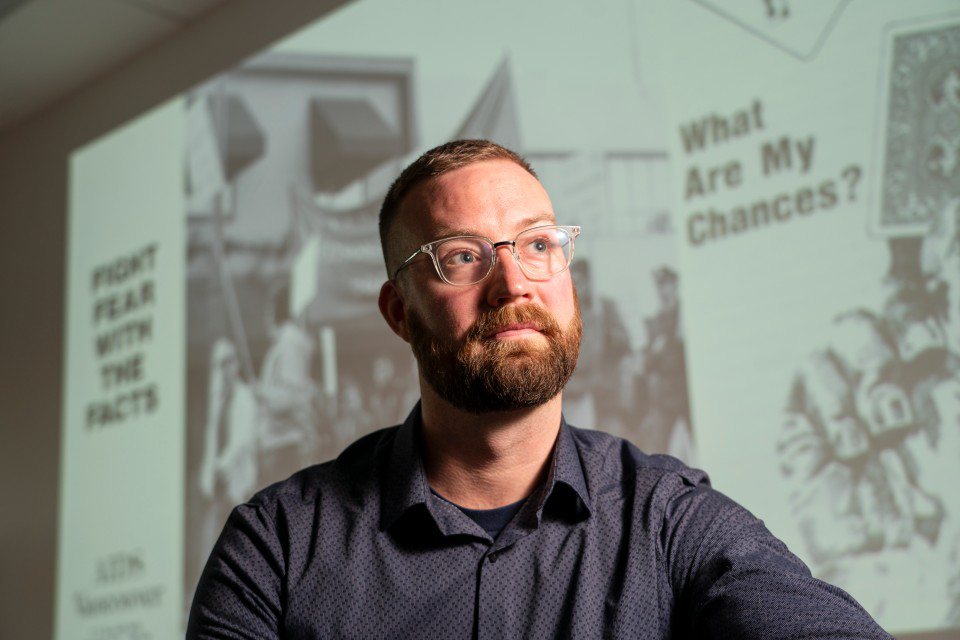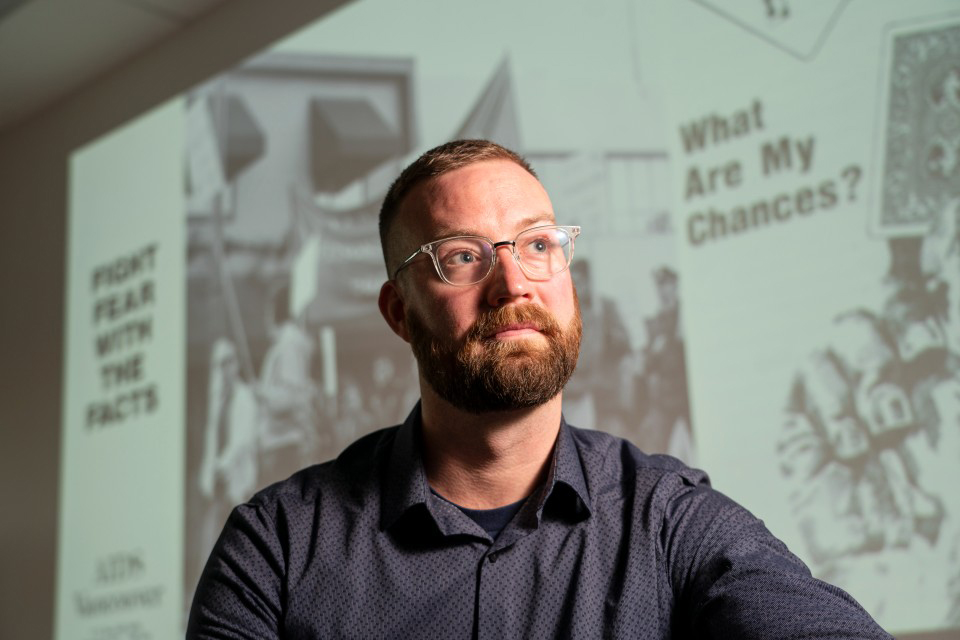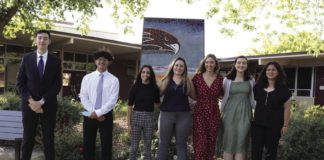Four decades after the start of the pandemic that has claimed 40 million lives, University of Victoria researchers are spotlighting the stories of British Columbians who lived through the early days of the HIV/AIDS epidemic. HIV In My Day, a community-based oral history project led by Nathan Lachowsky, associate professor of public health and social policy, captures the stories of almost 120 long-term HIV survivors and caregivers. The collection of interviews, conducted between 2017 and 2020, are publicly and digitally available online through UVic Libraries.
Now, the stories of these survivors have been transformed into theatre. The verbatim play, In My Day, will premiere at Vancouver’s The Cultch theatre and runs Dec. 2-11. Read more about In My Day in UVic News.
Lachowsky talks about the archival project and the play ahead of World AIDS Day, Dec. 1.

Nathan Lachowsky in front of UVic Libraries archival material from the beginning of the HIV/AIDs pandemic.. Credit: UVic Photo
Q: What was the inspiration behind the oral history project, HIV In My Day?
A: There was this feeling that we hadn’t told our history out west which was so different from what happened in New York, San Francisco and Toronto. We knew that certain voices had been centered in the telling of the history and that we needed to consider whose voices needed to be lifted up. We also knew there had been immense loss in the community. While we now have effective treatment for HIV, it continues to persist as a challenge for the queer community as well as for many other communities.
Also, older people living with HIV were dying of old age, which is something that people never thought would happen at the beginning of the pandemic. And they were also dying from suicide, isolation and loneliness. Preservation was an important piece of the conversation from the beginning.
Q: What themes emerged as you spoke to survivors and their caregivers?
A: From the outset of the project, some of the important themes we heard was around activism—direct-action activism during protests on the street, as well as very creative ways of garnering attention when no one wanted to listen and no one wanted to act. In BC, the provincial government was trying to force-quarantine people living with HIV. It wasn’t just government inaction; it was government opposition. Also the way that people provided care for each other and the way that people showed up beyond community lines.
Caregiving was another theme that really came through. It hasn’t been talked about much and I think that’s because of gender bias. But that was a huge part of what made everything possible— taking care of people so they could be well enough to be activists on the street, and when their immune systems were extremely low or damaged. It was largely a community response, not one from formal health care institutions.
Q: What sense of community existed at this time?
A: Vastly different types of people were impacted by HIV—hemophiliacs, women, folks from the Downtown Eastside, folks who were unhoused, gay men, etc. who were not necessarily connected before. This infection connected people who were trying to figure out ways of working in solidarity across those differences and this was an important part of the HIV response. Solidarity was valued and it’s something we need around anti-Black racism, and in movements around reconciliation, anti-Indigenous racism in health care, and murdered and missing Indigenous women. This need for solidarity is as present now as it was then. When we only focus on benefits or gains for ourselves or our own communities, that’s when we’ve lost the fight.
Q: How do you think governments have handled the HIV/AIDS pandemic compared with COVID and the toxic drug poisoning emergency?
A: One big difference is how quickly the government responded and mobilized the entire public health infrastructure to try to manage COVID. That’s not been the experience with the toxic drug supply emergency, and that was not the experience with HIV. At the beginning of the HIV pandemic, denial was the fundamental response. That is partly why we continue to see a persistent HIV pandemic now; the legacy of how we responded lives with us. There is still no HIV vaccine. There are effective preventive medications and effective treatment medications for those living with HIV, but the realities are so different even in terms of the science.
Q: How did you go about capturing a diversity of stories and experiences?
A: At every step of the project, people from HIV-affected communities and people who lived through the onset of HIV/AIDS in BC were involved. The beauty of using an oral history approach is hearing the individual person’s story and really listening to and following their experience. Having more than 100 interviews allowed us to hear so much of that diversity of experience. We did what we could to harness a diverse range of participants and voices but there are still challenges with representation. Some communities experienced death. Some people still aren’t ready to talk about their experiences. The project has been supported by a few different collectives. Our partners include YouthCO HIV & Hep C Society, AIDS Vancouver, Vancouver Island Persons with AIDS Society, and the Community Based Research Centre.
Q: How did the play, In My Day, come about?
A: When we started this project, we did not plan to make a play. That’s one of the beautiful things about community-based research. As you go, you build relationships and you make connections and opportunities arise out of that. One of the people connected to the project was a playwright, Rick Waines. He spent time learning how to do verbatim theatre. The power behind verbatim theatre and why it works so well with oral history is because it uses the direct voices of participants to tell the story. We had an amazing collection of 100-plus stories that participants had consented to share; normally for playwrights that would involve a tonne of work. Rick created this script and through the support of different folks, was able to get it launched at The Cultch. Our community-based research team helped bring a lens around antiracism, equity and justice as the play developed. It has been an amazing collaboration with artists and producers and directors. It’s opened my eyes to what we can do as academics and researchers.
— 30 —
Stephanie Harrington (Communications officer, Faculty of Human and Social Development) at hsdcom@uvic.ca








